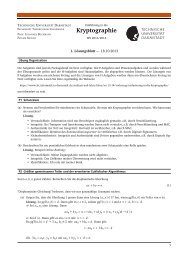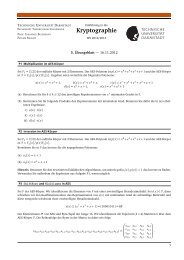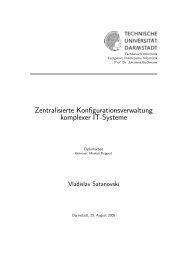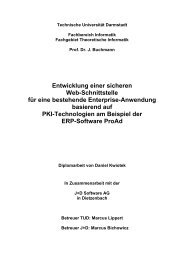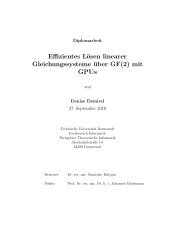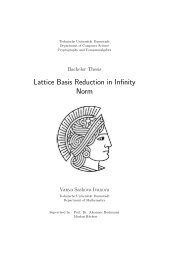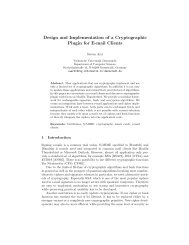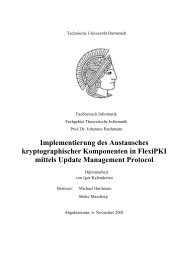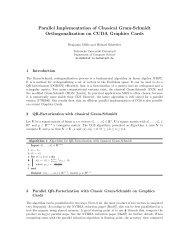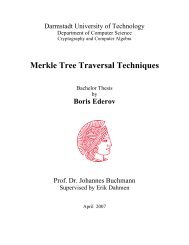An efficient mobile PACE implementation - CDC
An efficient mobile PACE implementation - CDC
An efficient mobile PACE implementation - CDC
You also want an ePaper? Increase the reach of your titles
YUMPU automatically turns print PDFs into web optimized ePapers that Google loves.
nario which is in the scope of this work. But it might be suitable for<br />
other scenarios, e.g. where the communication between the PICC<br />
and the PCD is secured against eavesdropping by other means.<br />
8. CONCLUSION<br />
This paper presented an <strong>efficient</strong> Java ME <strong>implementation</strong> of the<br />
<strong>PACE</strong> protocol for <strong>mobile</strong> devices. The review of the <strong>implementation</strong><br />
of the relevant algorithms and Java ME CSPs showed that<br />
there are significant performance differences. The following investigation<br />
of the possible optimizations to a straightforward <strong>PACE</strong><br />
version revealed different possibilities which all result in a similar<br />
theoretical speedup without changing existing CSPs. The presented<br />
benchmarks of the different possible optimizations were the basis<br />
for choosing concrete optimizations. The benchmarks revealed a<br />
significant speedup in comparison to the not optimized version. A<br />
discussion of potential side channel attacks on the optimized <strong>implementation</strong><br />
rounded the investigation up. The future work discussion<br />
showed that there is more optimization potential when making<br />
changes to the existing cryptographic libraries. All in all we succeeded<br />
in providing a platform independent <strong>efficient</strong> <strong>mobile</strong> <strong>PACE</strong><br />
<strong>implementation</strong>, but also showed where and how even more efficiency<br />
could be gained.<br />
9. REFERENCES<br />
[1] D. Agrawal, B. Archambeault, J. R. Rao, and P. Rohatgi. The<br />
em side-channel(s). In CHES ’02: Revised Papers from the<br />
4th International Workshop on Cryptographic Hardware and<br />
Embedded Systems, pages 29–45, London, UK, 2003.<br />
Springer-Verlag.<br />
[2] Australian Government Information Management Office<br />
(AGIMO). Australian Government Smartcard Framework.<br />
Phase 2, Version 0.12, Standards and Model Specification<br />
Part c, March 2007, 2007.<br />
[3] J. Bender, M. Fischlin, and D. Kügler. Security <strong>An</strong>alysis of<br />
the <strong>PACE</strong> Key-Agreement Protocol. In Information Security<br />
Conference, volume 5735 of LNCS. Springer, September<br />
2009.<br />
[4] C. Boyd and A. Mathuria. Protocols for Authentication and<br />
Key Establishment. Springer, 2003.<br />
[5] M. Ciet, M. Joye, K. Lauter, and P. Montgomery. Trading<br />
inversions for multiplications in elliptic curve cryptography.<br />
Designs, Codes and Cryptography, 39:189–206(18), May<br />
2006.<br />
[6] H. Cohen, A. Miyaji, and T. Ono. Efficient elliptic curve<br />
exponentiation using mixed coordinates. In Advances in<br />
Cryptology - ASIACRYPT ’98, volume 1514 of LNCS, pages<br />
51–65. Springer, 1998.<br />
[7] Comité Européen de Normalisation (CEN). Identification<br />
card systems - European Citizen Card - Part 1-4. (Draft of)<br />
Technical Specification, 2008.<br />
[8] W. Diffie and M. E. Hellman. New directions in<br />
cryptography. IEEE Transactions on Information Theory,<br />
22(6):644–654, 1976.<br />
[9] European Commission (IDABC). eID Interoperability for<br />
Pan-European Government Services, 2009. http://ec.<br />
europa.eu/idabc/en/document/6484/5644.<br />
[10] Federal Ministry of the Interior. Introduction of the<br />
electronic Identity Card in Germany. BMI IT4-644<br />
004/14#5, 02.07.2008, Einführung des elektronischen<br />
Personalausweises in Deutschland, Grobkonzept - Version<br />
2.0, in German, 2008.<br />
http://netzpolitik.org/wp-upload/bmi_<br />
epa-grobkonzept-2-0_2008-07-02.pdf.<br />
[11] Federal Office for Information Security (Bundesamt für<br />
Sicherheit in der Informationstechnik). Advanced Security<br />
Mechanism for Machine Readable Travel Documents -<br />
Extended Access Control (EAC), Password Authenticated<br />
Connection Establishment (<strong>PACE</strong>), and Restricted<br />
Identification (RI). Technical Directive (BSI-TR-03110),<br />
Version 2.05, 2010. https:<br />
//www.bsi.bund.de/SharedDocs/Downloads/<br />
EN/BSI/Publications/TechGuidelines/<br />
TR03110/TR-03110_v205_pdf.pdf.<br />
[12] D. Hankerson, A. Menezes, and S. Vanstone. Guide to<br />
Elliptic Curve Cryptography. Springer, 2003.<br />
[13] B. Henhapl. On the efficience of elliptic curve cryptography,<br />
2003.<br />
[14] T. Icart. How to hash into elliptic curves. In Advances in<br />
Cryptology - CRYPTO 2009, volume 5677 of LNCS, pages<br />
303–316. Springer, 2009.<br />
[15] International Civil Aviation Organization (ICAO). Machine<br />
Readable Travel Documents - Part 1: Machine Readable<br />
Passport, Specifications for electronically enabled passports<br />
with biometric identification capabilities. ICAO Doc 9303,<br />
2006.<br />
[16] International Civil Aviation Organization (ICAO). Machine<br />
Readable Travel Documents - Part 3: Machine Readable<br />
Official Travel Documents, Specifications for electronically<br />
enabled official travel documents with biometric<br />
identification capabilities. ICAO Doc 9303, 2008.<br />
[17] International Civil Aviation Organization (ICAO).<br />
Supplemental Access Control for Machine Readable Traval<br />
Documents. ISO/IEC JTC1 SC17 WG3/TF5 for ICAO,<br />
Version 0.8, Draft of 12.10.2009, 2009.<br />
[18] International Civil Aviation Organization (ICAO).<br />
Supplemental Access Control for Machine Readable Travel<br />
Documents, 2009.<br />
[19] ISO/IEC. ISO/IEC 14443-1: Identification cards -<br />
Contactless integrated circuit(s) cards - Proximity cards -<br />
Part 1-4. International Standard, 2001.<br />
[20] ISO/IEC. Identification cards – Integrated circuit cards,<br />
ISO/IEC 7816, 2004.<br />
[21] ISO/IEC. Information technology – Telecommunications and<br />
information exchange between systems – Near Field<br />
Communication – Interface and Protocol (NFCIP-1),<br />
ISO/IEC 18092, 2004.<br />
[22] ISO/IEC. Information technology – Telecommunications and<br />
information exchange between systems – Near Field<br />
Communication Interface and Protocol -2 (NFCIP-2),<br />
ISO/IEC 21481, 2005.<br />
[23] Juniper Research. 1 in 6 <strong>mobile</strong> subscribers to have NFC<br />
Mobile Phones by 2014. Press Release, 09.11.2009, 2009.<br />
http://juniperresearch.com/shop/<br />
viewpressrelease.php?pr=163.<br />
[24] P. Kocher. Timing Attacks on Implementations of<br />
Diffie-Hellman, RSA, DSS, and Other Systems. Advances in<br />
Cryptology-CRYPTO’96, 16th <strong>An</strong>nual International<br />
Cryptology Conference, Santa Barbara, California, USA,<br />
August 18-22, 1996, Proceedings, 1109:103–113, 1996.<br />
[25] P. Kocher, J. Jaff, and B. Jun. Differential Power <strong>An</strong>alysis.<br />
Advances in Cryptology-CRYPTO’99, 19th <strong>An</strong>nual<br />
International Cryptology Conference, Santa Barbara,<br />
California, USA, August 15-19, 1999, Proceedings,





